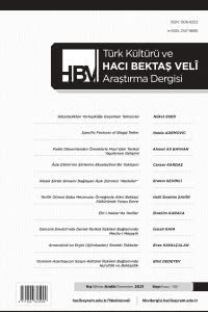15.-16. YÜZYILLARDA BEDAHŞAN İSMAİLİLERİ ARASINDAKİ Şİİ-TASAVVUFİ HAREKETLER VE SAFEVÎ ETKİSİ
SHIITE-MYSTICAL MOVEMENTS AMONG ISMAILIS OF BADAKHSHAN AND THE SAFAVID INFLUENCES IN THE 15TH- 16TH CENTURIES
___
AY, Z. (2014). Nasır-ı Hüsrev ve sonrasında bedahşan ismailileri (10.-15.-yüzyıllar). İstanbul: Tarih Vakfı Yurt Yayınları.BALDİCK, J. (2002). Mistik islam (çev. Yusuf Said Müftüoğlu). İstanbul: Birey Yayıncılık.
BERTELS, A. E. (1959). Nasır-ı khosrov i Ismailizm, Moskova: yy.
____. (1970). Penc risale-i felsefi, ed. A. E. Bertels. Moskova.
----. (1976). Nazariyat-ı berhi az 'urafa ve Şiaan-ı Eşnaaşeri Race Be erzaş-ı miras-ı ebedi Nasır-ı Husrev. Yad-Name-ye Naser-e Khosraw, Ferdowsi University, Faculty of Letters and Humanities, Mashad, 96-121.
----. (1987). Nasır-ı Khusraw. EI (birinci baskı, cilt 6). Leiden: E. J. Brill, 869-870.
BİDDULPH, J. (1977). Tribes of the Hindoo Koosh, Karaçi: Indus Publications.
DAFTARY, F. (2001). Muhalif İslam'ın 1400 yılı: İsmaîlîler tarih ve kuram, (çev. Ercüment Özkaya). İstanbul: Rastlantı Yayınları.
HERATİ, H. H. (1935). Kelam-ı pir, ed. W. Ivanow. Bombay.
ILOLİEV, A. (2008a). Popular culture and religious metaphor: saints and shrines in Wakhan region of Tajikistan. Central Asian Survey, 27(1): 59-73.
----. (2008b). The Ismaili-sufi sage of pamir: mubarak-i wakhani and the esoteric tradition of the Pamiri muslims. Amherst-New York: Cambria Press.
ISKANDAROV, B. I. (1973). Predislovie, Kurban Muhammad-zoda (Ahun Sulayman) ve Muhabbat Şoh-zoda (Seyid-Futur-Şo), Tarih-i Badahşan (Istoriya Badahşana), haz. Bahadur Iskandarov, Moskova: Vostochnaya literatura, 5-29.
IVANOW, W. (1959). Sufism and Ismailism: Chiragh-nama. Revue Iranienne d'Anthropo- logie, 3: 13-17, 53-70.
JAMAL, N. E. (2002). Surviving the Mongols: Nizari Quhistani and the community of Ismaili tradition in Persia. Londra-New York: I. B. Tauris.
Kurban Muhammad-zoda (Ahun Sulayman) ve Muhabbat Şoh-zoda (Seyid-Futur-Şo). (1973). Tarih-i Badahşan (Istoriya Badahşana), Tarih-i Badahşan (Istoriya Badahşana), haz. Bahadur Iskandarov, Moskova: Vostochnaya literatura.
MOEZZİ, M. (2011). Bedahşan İsmaililerine Ait Elyazmaları (çev. Ali Ertuğrul). DEÜİFD, XXXIII, 255-273.
POURJAVADY, N. ve WILSON, P. L. (1975). Isma'ilis and Ni'matullahis. Studia Islamica, 41, 113-135.
RİECK, A. (1995). The Nurbakhshis of Baltistan: crisis and revival of a five centuries old community. Die Welt des Islams, New Ser, 35(2), 159-188.
TOGAN, Z. V. (2010). Yeseviliğe dâir bazı yeni malumat. Fuad köprülü armağanı. Ankara: Türk Tarih Kurumu Yayınları, 523-529.
VİRANİ, S. N. (2007). The Ismailis in the middle ages: a history of survival, a search for salvati- on. Oxford: Oxford University Press.
- ISSN: 1306-8253
- Yayın Aralığı: 4
- Başlangıç: 1994
- Yayıncı: Ankara Hacı Bayram Veli Üniversitesi Türk Kültürü Açısından Hacı Bektaş-ı Veli Araştırmaları Uygulama ve Araştırma Merkezi
ALEVİ KÜLTÜRÜNDE ÇOCUK YETİŞTİRME VE KADININ KONUMU
HACIBEKTAŞ VELİ MÜZESİ'NDEKİ SANCAK ALEMLERİ
BİR PROPAGANDA ARACI OLARAK DİVAN ŞİİRİ KIZILBAŞ ÖRNEĞİ*
CEP SAAT MOTİFLİ YAKAPINAR KÖYÜ TAHTACI MEZAR TAŞLARI
ANADOLU SAHASI MASALLARINDA KAHRAMANIN DOĞUMU VE KAHRAMAN OLMA SÜRECİ
DEDELİK VE OZANLIK İLİŞKİSİ(KANGALLI DEDE OZANLAR ÖRNEĞİ)*
15.-16. YÜZYILLARDA BEDAHŞAN İSMAİLİLERİ ARASINDAKİ Şİİ-TASAVVUFİ HAREKETLER VE SAFEVÎ ETKİSİ
SİYASETE RİAYET ETMEK, BANİLİKTEN VAZGEÇMEK: DULKADİRLİ BEYİ ŞEHSUVAROĞLU ALİ BEY'İN HACIBEKTAŞ
